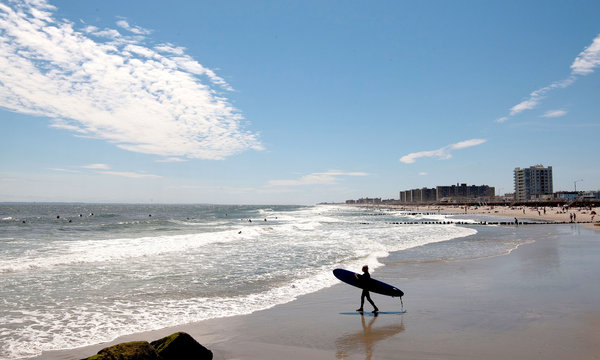But this season,
there will be one fewer hospital to deal with
such traumas.
In April, the
troubled Peninsula Hospital Center closed,
unable to stay solvent after its lab failed a
state exam and was shut down by the New York
State Health Department, which said the lab was
dangerous for patients.
Much like a reported
sighting of a shark fin off shore, the situation
has the residents of this beach town frenzied at
what may perhaps be an imagined danger. Only St.
John’s Episcopal Hospital remains on the
peninsula — 11.5 miles long and three quarters
of a mile wide — to pick up the slack, serving a
large chunk of the 115,000 working- and
middle-class year-round residents.
A spokesman for the
department, Bill Schwarz, said the presence of
local walk-in clinics meant the spit was not in
danger. “We are confident that they have the
capacity and capability to deal with that
increase in the summer population,” he said in
an interview.
Communities always
reel from the loss of such facilities, but
residents here say the topography of their
enclave heightens the danger. In cooler weather,
the population may be relatively small, but each
summer it hosts several million day-trippers:
more than 3.6 million people visited the public
Rockaway Beach last year during the three-month
period it is officially open, which begins this
week.
That swell, those
who fought the closing fear, may strain the
emergency room of the spit’s one remaining
hospital to bursting. While there are other
hospitals just across the water, the area’s
unique geography, they say — it is linked only
by three bridges and the mainland at its base,
all arteries that jam with traffic on warm days
— could ensnare ambulances at times when every
second counts.
Peninsula had such a
dubious reputation that some residents said they
had avoided it altogether. St. John’s asserts
that despite a potential upsurge, it can handle
the summer crush.
Nonetheless,
hundreds of residents and former hospital
employees gave impassioned testimony to the
contrary before a panel this month at a legally
required meeting on the closing; the panel
included Dr. Nirav R. Shah, the state health
commissioner.
“People are going to
die because they won’t get off the peninsula
here,” said Bernie Feuer, who runs parking at
the beachside Jacob Riis Park. Since 2000 there
have been 16 drowning deaths in the waters off
Rockaway Peninsula, according to the New York
City Department of Health and Mental Hygiene.
“Every summer there
are people pulled out of our ocean,” Linda
Ruscillo, 63, said at the meeting. “Some make it
and some don’t. What are the odds for the ones
that do make it but must go to St. John’s?”
Without a
functioning lab, Peninsula Hospital was
effectively hamstrung, unable to perform a vast
majority of services like blood tests or
transfusions. Forced to cancel operations, it
transferred almost all of the patients in the
173-bed hospital to other medical centers.
“It comes down to
patient safety,” Mr. Schwarz said. The State
Health Department rejected a plan by Peninsula
Hospital to fix the lab. “It has a lab with
serious deficiencies,” he said. “They submitted
a plan that was unacceptable.”
The loss of most
patient income toppled the insecure finances of
the hospital, which had already filed for
bankruptcy in September.
A trustee appointed
by a federal bankruptcy court, Lori Lapin Jones,
determined that the hospital’s shaky finances
made reopening impossible, Mr. Schwarz said. The
hospital’s assets are to be sold in the coming
months.
“Given the
deficiencies that the state cited, the need for
capital, the financial situation, there were
insufficient resources in the opinion of the
trustee,” said Daniel McMurray, the patient care
ombudsman appointed by the bankruptcy court. “It
was time to reach that difficult situation.”
As with the painful
recent closings of St. Vincent’s Hospital
Manhattan in Greenwich Village, North General
Hospital in Harlem and Mary Immaculate in
Queens, the community has railed against the
decision to shut it down.
Voices shook and
tears were shed at the meeting this month at the
Knights of Columbus Hall. It was held because a
recent law requires the State Health Department
to hold a public forum when a hospital is closed
and report afterward on how the community’s
needs will be addressed.
“I wish there was a
silver bullet that said, ‘Do this one thing and
it will fix the problems,’ ” Dr. Shah said at
the meeting.
But just how real
the threat is seems in dispute. Even in the
summer months, St. John’s does not usually
experience an increase in emergency room visits,
which average around 100 a day, a hospital
spokeswoman said. And there are several urgent
care facilities on the strip, like the Joseph P.
Addabbo Family Health Center, near the mainland.
Some people, like
Adi Carter, 33, a yoga teacher and part-time
resident, say Peninsula Hospital, which served a
low-income and elderly population, had a
reputation for spotty care. Ms. Carter said she
routinely administered first aid to wounded
fellow surfers in the bungalow she shares on
Beach 91st Street, rather than send them to
Peninsula, after local firefighters warned her
of the hospital’s reputation.
Nevertheless,
Peninsula’s absence is being felt. The emergency
room at St. John’s, which was last renovated in
the 1960s, was designed to serve 15,000 patients
a year, but it treats double that number, said
Penelope Chin, a spokeswoman for St. John’s.
Since Peninsula closed, emergency room visits
are up 35 percent. As for inpatient care, about
85 percent of the hospital’s beds are in use, up
11 percentage points since Peninsula closed.
“It’s really
unfortunate that Peninsula closed, and we face
many challenges here on the peninsula,” Ms. Chin
said. “The staff has been caring for the influx
of emergency patients as best they can.”
